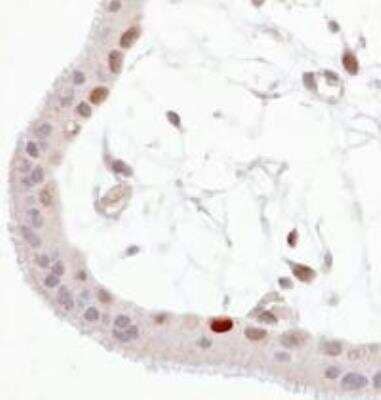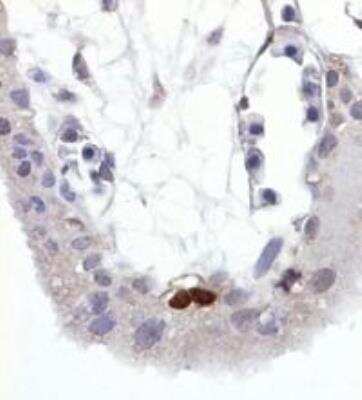p53 [p Ser392] Antibody (FP3.2 [FPS392]) - BSA Free
Novus Biologicals, part of Bio-Techne | Catalog # NB500-575


Conjugate
Catalog #
Key Product Details
Species Reactivity
Human
Applications
Immunohistochemistry, Immunohistochemistry-Paraffin, Western Blot
Label
Unconjugated
Antibody Source
Monoclonal Mouse IgG1 Clone # FP3.2 [FPS392]
Format
BSA Free
Concentration
1.0 mg/ml
Product Specifications
Immunogen
KLH-conjugated phosphopeptide RHKKLMFKTEGPDS[P]D, corresponding to amino acids 378-393 of human p53.
Modification
p Ser392
Specificity
The antibody FP3.2 [FPS392] reacts with human p53 tumour suppressor protein phosphorylated at CKII site (Ser 392).
Clonality
Monoclonal
Host
Mouse
Isotype
IgG1
Scientific Data Images for p53 [p Ser392] Antibody (FP3.2 [FPS392]) - BSA Free
Immunohistochemistry: p53 [p Ser392] Antibody (FP3.2 [FPS392]) [NB500-575] - Wild-type p53 expressed in human trophoblast (paraffin-embedded sections). 1A - anti-p53 (total).
Immunohistochemistry: p53 [p Ser392] Antibody (FP3.2 [FPS392]) [NB500-575] - 1B anti-P53 (phospho Ser392) Note that some of total p53 positive nuclei are also FP3.2 (phospho p53) positive.
Applications for p53 [p Ser392] Antibody (FP3.2 [FPS392]) - BSA Free
Application
Recommended Usage
Immunohistochemistry
1:10-1:500
Immunohistochemistry-Paraffin
10 ug/ml
Western Blot
1 ug/ml
Application Notes
Immunohistochemistry-Paraffin sections - Staining technique: standard ABC technique (DAB+) Pretreatment: high temperature antigen retrieval (microwave, pressure cooker) in 10 mM citrate buffer pH 6.0 or 1 mM EDTA-NaOH buffer pH 8.0 Recommended dilution: 10 ug/ml Incubation: 1 hour at RT; or overnight at 4C
Formulation, Preparation, and Storage
Purification
Protein A purified
Formulation
PBS (pH 7.4)
Format
BSA Free
Preservative
0.09% Sodium Azide
Concentration
1.0 mg/ml
Shipping
The product is shipped with polar packs. Upon receipt, store it immediately at the temperature recommended below.
Stability & Storage
Store at 4C. Do not freeze.
Background: p53
Alternate Names
BCC7, LFS1, TP53, TRP53
Gene Symbol
TP53
UniProt
Additional p53 Products
Product Documents for p53 [p Ser392] Antibody (FP3.2 [FPS392]) - BSA Free
Product Specific Notices for p53 [p Ser392] Antibody (FP3.2 [FPS392]) - BSA Free
This product is for research use only and is not approved for use in humans or in clinical diagnosis. Primary Antibodies are guaranteed for 1 year from date of receipt.
